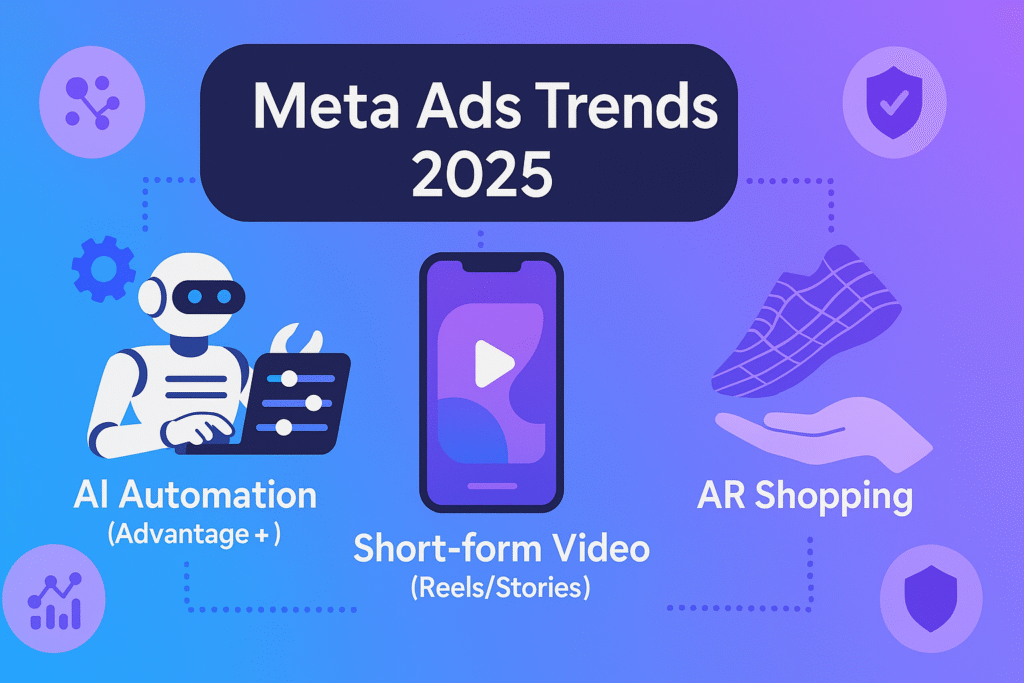
TL;DR: In 2025, Meta performance belongs to teams that combine AI‑assisted automation, short‑form video that mirrors native behavior, and friction‑free shopping. Treat the algorithm as a partner: feed clean conversion signals, ship diverse creatives by funnel stage, and run a weekly learn‑and‑iterate loop. This guide covers the biggest Meta Ads trends, the why behind them, and practical checklists you can deploy this week.
1) AI‑assisted automation (Advantage+) with strong guardrails
Advantage+ (campaigns, creatives, catalog) works best when your inputs are strong: valuable conversion events, high‑quality feeds, and first‑party audiences. The goal isn’t to “set and forget”—it’s to guide the system with clear objectives and constraints.
- When to use: large catalogs, many SKUs, or multiple offers where human micro‑management doesn’t scale.
- How to guide: separate new vs. returning customers; group products by similar AOV and margins; send value signals (
purchasewith revenue) and exclude recent buyers when appropriate. - Common pitfalls: weak conversions (e.g., button clicks), one‑size‑fits‑all creatives, and no exclusions.
Case snapshot: an apparel DTC brand enabled Advantage+ Shopping with value events and a richer product feed (material, fit, color). With weekly creative refresh and audience signals, ROAS rose ~28% in 30 days at flat spend as budget shifted from under‑performing manual ad sets to the best automated sets.
2) Short‑form video becomes default
Reels and Stories are the native currency on Meta. Winning ads hook in 2–3 seconds, show proof quickly, and respect the 9:16 canvas.
- Hook fast: promise, pain point, or benefit in the first seconds.
- Show, don’t tell: UGC, before/after, quick demos, social proof overlays.
- Readable: captions on‑screen, big text, fast cuts every 1–2s.
- CTA in context: “See sizes/colors”, “Start free trial”, “Shop this style”.
Execution tip: build 10–15 variations per “angle” (pain, benefit, proof, price). Allocate ~70% budget to proven variations and ~30% to new angles each week.
3) AR try‑on & immersive shopping
Augmented reality (AR) try‑ons lift engagement and consideration even when they’re not last‑click drivers. Best fits include beauty, eyewear, footwear, and home decor.
- What to measure: view time, CTR lift, brand search upticks, assisted conversions in blended reporting.
- Creative approach: show the AR interaction quickly; layer sizing/color options; use creator guidance.
Example: an eyewear brand built an AR filter to try frames. The campaign increased view time and drove an ~18% CTR lift on cold audiences while branded search rose the following week—indicating real upper‑funnel impact.
4) Catalogs and product feeds with richer attributes
Dynamic ads perform better when feeds reflect real decision drivers: material, fit, variants, price by size, regional availability. Name products with searchable attributes (“lightweight 200g running shoe”, “10k waterproof jacket”).
B2B note: create a “pseudo‑catalog” of plans, templates, or packages and use creative automation to tailor value props by segment.
5) Data‑informed creatives (Search & GA4 → Social)
Mine Search Terms and GA4 to fuel social messaging. High‑converting phrases become headlines; objections become bullets; proof becomes hooks. Connect your measurement stack—see our guide GA4 + Tag Manager Conversion Setup.
6) Privacy, attribution & measurement reality
With Consent Mode, Conversions API (CAPI), and modeled conversions, measurement is triangulation. Set coherent attribution windows (e.g., 7‑day click, 1‑day view), compare Meta vs. GA4 vs. revenue/LTV, and make decisions on directional alignment rather than single‑source absolutes.
- Implement CAPI and valuable events (
purchase,subscribe, qualifiedgenerate_lead). - Align windows to sales cycle and channel role.
- Use blended MER/CAC at the portfolio level to spot real lift.
For multi‑channel plays, also read Affiliate Marketing with Paid Ads and Facebook Ads vs TikTok Ads.
7) Lean, auditable account structure
Organize by theme (product or solution). For each theme, map three roles:
- Exact/Defend: protect high‑intent (often via Search) and brand demand.
- Scale: extend inside the theme with controlled expansion.
- Discovery: top‑of‑funnel with short‑form video and broad audience signals.
In Meta, this often means 2–3 campaigns per theme (new vs returning), 3–5 ad sets, and many creative variations. Keep budgets at the theme level to feed learning.
8) Weekly operating system
- Creative repo: save every asset with tags (angle, product, funnel, date). Identify repeatable winners.
- Testing cadence: ship 3–5 new variations weekly; pause after ~2× tCPA with no qualified conversions.
- Mining loop: collect comments/DMs and Search phrases; turn them into new angles and hooks.
Checklists you can copy
Launch
- Install CAPI + Consent Mode; verify events with value.
- Build first‑party audiences (buyers, high‑LTV, subscribers).
- Produce 10–15 short‑form variations per angle (hook, proof, price, objection).
- Define budgets and kill rules by theme.
Optimization
- Promote creative winners; refresh every 14–21 days.
- Reallocate 60–70% of budget to winners; keep 30–40% for exploration.
- Review attribution and triangulate with GA4/LTV.
Conclusion
2025 rewards teams that combine AI guidance, native formats, and trustworthy measurement. Simplify structure, invest in short‑form, test AR where it makes sense, and make decisions from value signals—not vanity metrics. Iterate weekly and document what sticks. Compounding small wins yields durable scale.